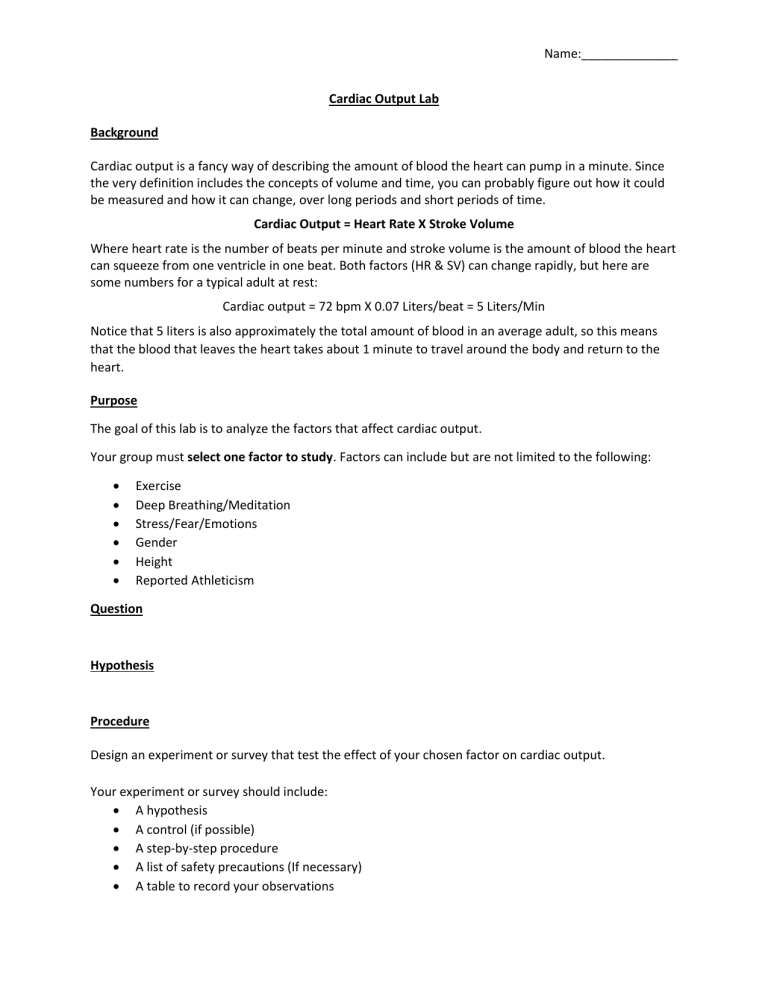
Name:______________ Cardiac Output Lab Background Cardiac output is a fancy way of describing the amount of blood the heart can pump in a minute. Since the very definition includes the concepts of volume and time, you can probably figure out how it could be measured and how it can change, over long periods and short periods of time. Cardiac Output = Heart Rate X Stroke Volume Where heart rate is the number of beats per minute and stroke volume is the amount of blood the heart can squeeze from one ventricle in one beat. Both factors (HR & SV) can change rapidly, but here are some numbers for a typical adult at rest: Cardiac output = 72 bpm X 0.07 Liters/beat = 5 Liters/Min Notice that 5 liters is also approximately the total amount of blood in an average adult, so this means that the blood that leaves the heart takes about 1 minute to travel around the body and return to the heart. Purpose The goal of this lab is to analyze the factors that affect cardiac output. Your group must select one factor to study. Factors can include but are not limited to the following: Exercise Deep Breathing/Meditation Stress/Fear/Emotions Gender Height Reported Athleticism Question Hypothesis Procedure Design an experiment or survey that test the effect of your chosen factor on cardiac output. Your experiment or survey should include: A hypothesis A control (if possible) A step-by-step procedure A list of safety precautions (If necessary) A table to record your observations Name:______________ To help you, a generic procedure for taking pulses and calculating cardiac output is provided: 1. For this activity, we need to get the pulse quickly. Therefore, I recommend only counting the pulse for 15 seconds and then multiplying by 4 (to get beats per minute). To take your pulse, place your index and middle finger near your wrist or neck as shown below. 2. Calculate cardiac output using the equation in the introduction (CO=HR x SV). Use 0.071 L/min to approximate SV. Results Analysis: 1. Create a line or bar graph of your data. 2. How did your chosen factor affect cardiac output? 3. Why do you think your chosen factor influenced (or did not influence) cardiac output? 4. Describe any problems or difficulties you had carrying out your procedure. 5. How could you improve your experimental design? Use the following information to answer number 6: Cardiac Output has direct influence over your Blood Pressure. Blood Pressure is the pressure exerted on the large systemic arteries near the heart. Blood Pressure is measured indirectly by auscultation (listening). Two pressures are actually measured. The first is the pressure in the arteries during the contraction phase of the heart cycle, it is the systolic pressure. The second pressure is measured during the resting phase and is called diastolic pressure. The other factor that has direct influence on blood pressure is peripheral resistance, the amount of friction encountered by the blood as it flows through the vessels. Blood Pressure = Cardiac Output x Peripheral Resistance 6. Based on your data, do you think your chosen factor has an effect on blood pressure? Why or why not?






